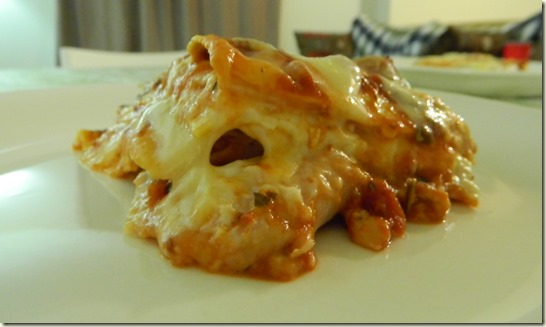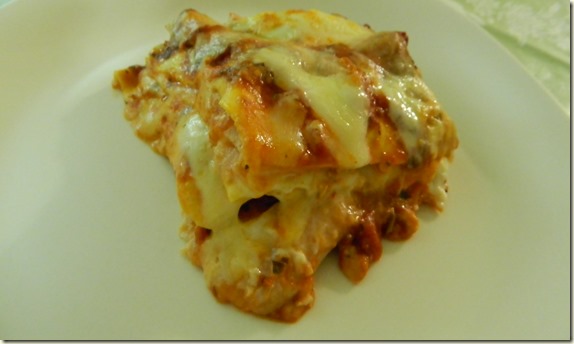
This Turkey and Cheese Lasagna recipe is so easy and so delicious that it became a staple in my house. We usually make it for Sunday lunch and when there is any left, which is rare, we serve it the next day and it surprisingly still tastes great if not even better.
Using turkey makes it a healthier alternative to ham or meat lasagna, but if you want a vegetarian version, just substitute turkey for steamed spinach stir-fried with some olive oil and garlic. It’s also one of my favorites and it tastes just as good.
*What kind of pasta should I use?
Well, there are two types of lasagna sheets, the dry ones and the fresh ones. I definitely prefer fresh pasta for this recipe because it’s easier to use and you get a better result. But maybe you can only find dry sheets and that’s ok too. Just be careful when lining the pan not to break the sheets. The instructions to build the lasagna are the same, but make sure you add a little more sauce to help it cook properly.
*How many layers should I use and what combinations should I make for the filling?
You can make as many layers as you’d like, but I personally believe 4 layers are more than enough, in fact my lasagna pan holds exactly 4 layers, and my grandma, who was Italian, used to make it with 4 as well. I learned from her that the top layer should be cheese so you should always start with béchamel + meat/ turkey/ spinach or whatever you decide to use and the second layer should be: pasta + tomato sauce + cheese. That way, when you get to the top layer it will always be tomato sauce and cheese.
You can make many different combinations, using any kind of meat or veggies (bolognese, shredded chicken, turkey, spinach, ricotta cheese, feta cheese, olives, etc) and a sauce (béchamel, Alfredo, pesto, tapenade, etc). But try to use the tomato sauce + cheese combination for the top layer to keep it a little traditional.
*How much sauce, meat, cheese is necessary?
Well, it is important to cover all the pasta with sauce, even the corners to make sure it doesn’t dry out in the oven. With that in mind:
My pan is about 13’’ X 8’’ or 33cm X 20.3cm. I use 1 pack of turkey breast with about 400g and the same amount of cheese, sometimes a little more (500g should be enough). 1 glass container of tomato sauce () and the béchamel recipe usually yields a little more than needed. The lasagna sheets usually come in 2 packs (at Costco) and 1 is more than enough.
*What do I do with leftovers?
I use them for cannelloni or manicotti (with ricotta and spinach or veggies). 1 pack of lasagna sheets that I simply roll with the filling of choice and the leftover béchamel.
cannelloni or manicotti

I hope you enjoy it as much as I do.
Ingredients:
Lasagna sheets (fresh pasta – ready for use, no boil)
Béchamel sauce or Alfredo sauce (I used homemade béchamel – recipe follows)
Organic tomato sauce
Turkey breast (cold cuts – the ones used for sandwiches)
Mozzarella cheese (sliced or grated)
Parmigiano cheese (grated)

Instructions:
1- Start by spreading a little of the tomato sauce all over the pan to make sure the pasta doesn’t stick to the bottom.
2- Start layering the pasta, cut the excess parts and place them closely to fill up the whole pan, from side to side. There will be 4 layers of pasta in total.
3- The bottom layer is topped with béchamel sauce and turkey. Spread the béchamel all over the pasta and cover it with slices of turkey, don’t overlay or it will be too meaty later.
4- Cover it with pasta
5- The next layer is topped with tomato sauce and mozzarella cheese. Spread the tomato sauce all over the pasta and add the mozzarella.
6- Cover it with pasta.
7- Proceed with another layer of béchamel and turkey and cover it with pasta.
8- Proceed with another layer of tomato sauce and mozzarella cheese. This is the last layer /top layer.
9- Sprinkle Parmigiano on top of the mozzarella and cover the whole pan with aluminum foil, closing tightly.
10- Bake it at 350 F at the bottom rack of the oven for about 30 minutes.
11- Remove the aluminum foil and bake it at the top rack of the oven until it starts to boil. If the cheese is not completely melted by then, turn on the broiler and wait for the gratin effect (browning/ caramelization).
It’s ready to eat.
Cover it tightly with ceramic wrap and keep it in the fridge for a delicious lunch or dinner the next day.

For the homemade béchamel:
Honestly I never really measure the butter and flour, but the ratio should be as it follows.
1- Add 2 generous tablespoons of cold butter to a warm pan (medium heat).
2- Once it’s completely melted, remove from heat and add about 1 cup of flour to it. Mix well with a whisk until incorporated (it will turn into a paste or like coarse meal)
3- Add about 700ml of milk directly to the pan and keep whisking out of the heat. Add salt, pepper and nutmeg to taste.
4- Back on medium heat keep whisking until completely incorporated and thickened.
5- Keep it in the pan covered with a plastic wrap (touching the sauce) to keep the top from drying out.
How to fix problems with consistency:
- If it ends up not as thick as you’d like, just add a little more flour directly to the pan, whisking strongly to avoid lumps or dissolve 1 tablespoon of flour into 1 tablespoon of milk in a separate glass and add slowly to the sauce while whisking. It should do the trick.
- If you end up with a very thick sauce and would like to make it more runny, just add more hot milk at the end while whisking until you get the desired consistency. Just keep in mind that the sauce will thicken a little more after it starts to cool down.
If you enjoyed this recipe, please check out my videos and subscribe to my channel on youtube at: https://www.youtube.com/channel/UC4xeNKvmGMNP19K_qHGmm7w
And if you live in the Montreal area, please visit my web page at:
www.pastrydelights.ca and like my facebook page at: www.facebook.com/pastrydelightspage
Thanks :)
Andiara
No comments:
Post a Comment